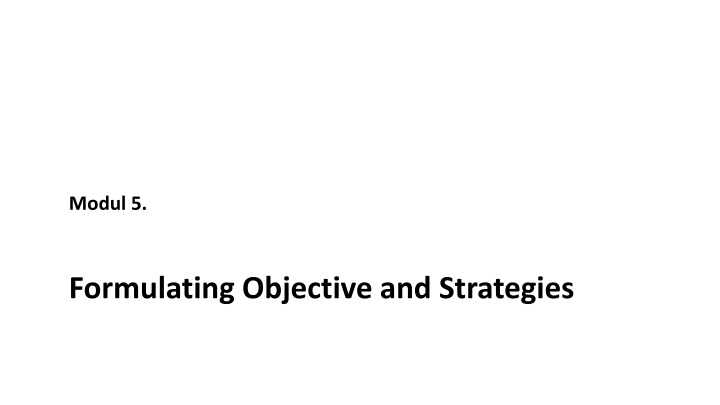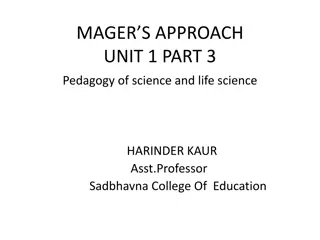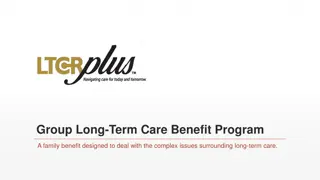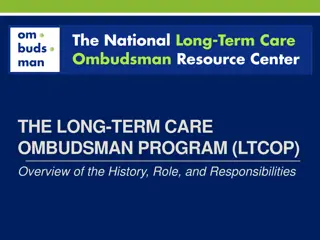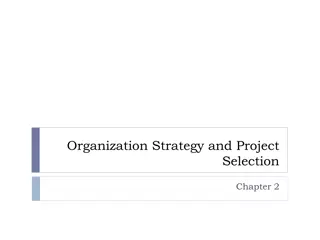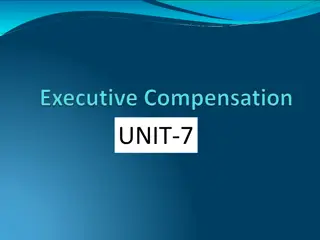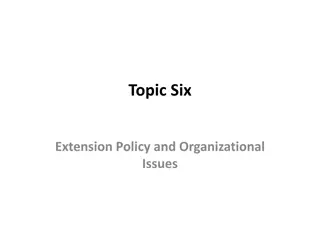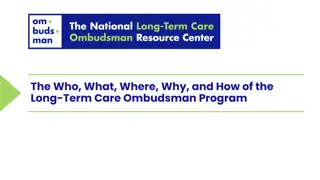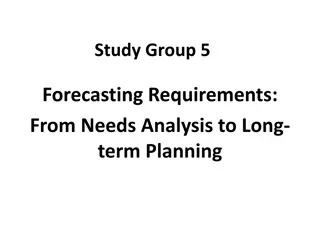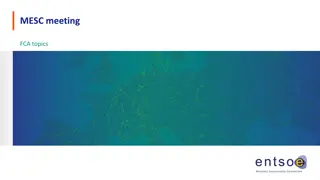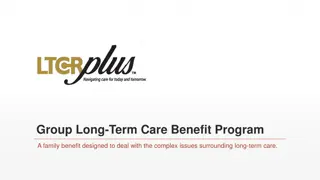Formulating Long-Term Objectives in Strategic Management
In strategic management, long-term objectives are crucial for guiding organizational success. They represent the expected outcomes of strategic actions and should be specific, measurable, and aligned with organizational goals. Clear objectives help provide direction, minimize conflict, and aid in resource allocation and decision-making. This article delves into the characteristics of long-term objectives, their importance in strategy formulation, and the distinction between financial and strategic objectives.
Uploaded on Apr 04, 2025 | 3 Views
Download Presentation

Please find below an Image/Link to download the presentation.
The content on the website is provided AS IS for your information and personal use only. It may not be sold, licensed, or shared on other websites without obtaining consent from the author.If you encounter any issues during the download, it is possible that the publisher has removed the file from their server.
You are allowed to download the files provided on this website for personal or commercial use, subject to the condition that they are used lawfully. All files are the property of their respective owners.
The content on the website is provided AS IS for your information and personal use only. It may not be sold, licensed, or shared on other websites without obtaining consent from the author.
E N D
Presentation Transcript
Modul 5. Formulating Objective and Strategies
Strategic Management Model Strategy Formulation Perform External Audit Strategy Implementation Strategy Evaluation Implement Strategies Mkt, Fin, R&D, Prod/Op, MIS Generate, Evaluate, Choose Strategies Implement Strategies Mgt Issues Measure, Evaluate Performance Develop Vision & Mission Statement Establish Long-term Objective Perform Internal Audit 2
notable quotes Alice said, would you please tell me which way to go from here? The cat said, that depends on where you want to get to Lewis Carrol Start from the end 3
What is Long-Term Objective ? Long-term objective, represent the results expected from pursuing certain strategies Strategies, represent the actions to be taken to accomplish long-term objectives Time frame for objective & strategies should be consistent 2 5 years.
Long-term Objective Objective should be quantitative, measurable, realistic, understandable, challenging, hierarchical, obtainable and congruent among organizational units. Term of objective : growth in assets, growth in sales, profitability, market share, degree and nature of diversification, earning per share and social responsibility. Varying performance measure by organizational level : Org Level Basis for Annual Bonus or Merit Pay Corporate Division Function 75% based on Long-term objectives 25% based on Annual Objectives 50% based on Long-term objectives 50% based on Annual Objectives 25% based on Long-term objectives 75% based on Annual Objectives 5
Characteristic of Objectives Quantitative Measurable Realistic Understandable Challenging Hierarchical Obtainable Congruent across departments
Benefits of Having Clear Objectives 1. Provide direction by revealing expectation 6. Minimize conflict 2. Allow synergy 7. Stimulate exertion 3. Aid in evaluation by serving as standard 8. Aid in allocation of resources 4. Establish priority 9. Aid in design of jobs 5. Reduce uncertainty 10. Provide basis for consistent decision making
Financial vs Strategic Objectives Financial Objectives Strategic Objective Growth in revenue Growth in earning Higher dividends Larger profit margin Greater ROI Higher EPS Rising Stock Price Improve Cash flow Larger market share Quicker on time delivery than rivals Shorter design-to-market times than rivals Lower cost than rivals Higher product quality than rivals Wider geographic coverage than rivals Achieving technological leadership Consistently getting new or improved product to market ahead than rivals
The Balanced Scorecard Untuk suskes secara finasial, bagaimana kita harus nampak di hadapan pemegang saham? Financial Internal Business Process Customer Untuk mencapai visi kita, bagaimana kita harus nampak di hadapan pelanggan Untuk memuaskan pemegang saham dan pelanggan, proses bisnis apa yang diperbaiki Visi & Strategi Learning and Growth Untuk mencapai visi kita, bagaimana akan mempertahankan kemampuan untuk berubah dan berkembang Ref : BSC (Kaplan) 9
Cont Cause and Effect Relationship Menggambarkan rantai dari logika yang merubah/ mentranformasikan dari aset tak berwujud menjadi nilai yang terukur Financial Perspective Long term shareholders value Revenue Growth Productivity Customer Perspective Customer Value Proposition Menjelaskan kondisi yang akan menciptakan Value untuk pelanggan Product & Service Attr.ibutes Relationship Image Price Quality Time Function Partnership Brand Internal Process Perspective Value Creating Processes Menentukan proses-proses yang akan Mentranfoemasikan aset tak berwujud Menjadi hasil keuangan dan Customer Operation Management Processes Customer Management Processes Regulatory and Social Processes Innovation Processes Clustering of Assets and Activities Menentukan aset tak berwujud yang harus diselaraskan dan diintegrasikan untuk menciptakan value Learning & Growth Perspective Human Capital Information Capital Organization Capital 10
Alternative Strategies Defined and Example Strategy Definition Example Starbucks reached a deal with Green Mountain Coffee Roater for that firm to sell packs of Starbucks Tazo-branded coffee and tea in their brewers Gaining ownership or increased control over distributors or retailers Forward Integration Seeking ownership or increased control of firm s suppliers Hilton Hotel could acquire a large furniture manufacturer Backward Integration Seeking ownership or increased control over competitors Pfizer acquires Wyeth; both are huge drug companies Horizontal Integration Seeking increased market share for present product or services in present market through greater marketing effort Mc Donald s spending million on its promotion aimed at convincing consumers it offers healthy items. Market Penetration Introducing present product or services into new geographic area Burger King opened its first in Japan Market Development Seeking increased sales by improving present product and services or developing new ones. Google introduced GooglePresents to compete with Microsoft Power Point Product Development 11
Cont Strategy Definition Example Adding new but related product or services AT&T acquiresof BellSouth Related Diversification Adding new unrelated product or services Ford Motor company entered the industrial bank business Unrelated Diversification Regrouping through cost and asset reduction to reserve declining sales and profit. Discovery Channel closed its103 mall-based and stand-alone stores to focus on the internet and laid 25%of its workforce Retrenchment Selling a division or part of an organization Whirpool sold its struggling Hoover floor-care business to Techtronic Industries Divestiture Selling all of a company s assets, in part, for their tangible worth Follow Me Charter sold all of its assets and ceased doing business Liquidation 12
Faktor faktor yang mempengaruhi pilihan strategi 1. Peranan strategi yang digunakan di masa lalu 2. Derajat ketergantungan organisasi terhadap pihak eksternal 3. Sikap terhadap resiko 4. Faktor politis di dalam organisasi 5. Pertimbangan waktu 6. Reaksi pesaing
Alternative Strategies Integration Strategies Intensive Strategies Forward Int Backward Int Horizontal Int Market Penetration Market Dev Product Dev Defensive Strategies Diversification Strategies Retrenchment Related Divers Unrelated Diversification Divestiture Liquidation
Levels of Strategies Large Company Small Comapny Corporate level, CEO Company level, owner or president Division level, EVP Functional level, marketing, finance, R&D, manufacturing, MIS, HR Functional level, marketing, finance, R&D, HRM production/operation, MIS Operational level, plant manager, sales manager, production and department manager Operational level, plant manager, sales manager, production and department manager.
Kelompok Strategi, Fokus Masalah, dan Instrumen Analisis Aras Strategi Fokus Instrumen Korporasi (bagaimana mengembangkan portofolio (himpunan) bisnis secara agregat memberi keuntungan terbesar bagi perusahaan secara finansial/non, persoalan diversifikasi, new biz entry, divestasi) Portfolio usaha Analisis Portofolio Bisnis (BCG, GE, ADL, dsb) Divisi (SBU) (Penciptaan daya saing Daya saing pada produk- pasar tertentu Analisis Kekuatan Persaingan (Analisis Industri) dan Strategi Generik (Porter) yang lestari untuk bisnis tertentu) Fungsional (efisiensi dan produktivitas penggunaan sumber daya org.) Produktivitas sumber daya Tergantung Fungsi-fungsi Hendrawan Supratikno dkk, 2005
Corporate Strategy Relationship in Single Business Top Management Corporate Strategy Middle & Supervisory Management Production Operation Management Policies & Plans Financial Policies and Plans Personal Labor relation Policies & Plans R & D Policies and Plans Marketing Policies & Plan Accounting Policies & Plans 17
Corporate Strategy Relationship in Multi Business Corporate Management Corporate Strategy SBU Top Management SBU-1 Strategy SBU-2 Strategy SBU-3 Strategy Middle & Supervisory Management Production Operation Management Policies & Plans Financial Policies and Plans Personal Labor relation Policies & Plans R & D Policies and Plans Marketing Policies & Plan Accounting Policies & Plans 18
The What of Companys Strategy Actions to gain sales and marketshare via lower prices, more performance features, more appealing design, better quality or customer service, wider production selection etc. Actions to diversity the company s revenues and earnings by entering new businesses Actions to respond to changing market conditions and other external circumtances Actions to strengthen competitive capabilities and correct competitive weaknesses Actions to enter new geographic or product markets or exit existing ones The pattern of actions and business approaches that define a company s strategy Actions and approaches that define how the company manages research and development, production, sales and marketing, finance and other key activities Actions to merge with or acquire rival companies Efforts to persue new market opportunities and defend against threats to the company s well-being Actions to form strategic alliances and collaborative partnerships
Strategi Korporat 1. Strategi Pertumbuhan : Bagaimana menggerakkan organisasi ke depan, peningkatan level operasi, tumbuh lebih cepat. a.Konsentrasi b.Integrasi vertikal c.Integrasi Horisontal d.Diversifikasi : Terkait dan tak terkait, Pengembangan internal, akuisisi, merger, joint venture, kerja sama dengan partner dari luar) 2. Strategi Stabilitas : Strategi dimana organisasi organisasinya dan level operasi bisnisnya sekarang. 3. Strategi Pembaruan: Bagaimana membalik kinerja organisasi yang cenderung menurun -> Pengurangan (retrenchment) dan perubahan haluan (turnaround) mempertahankan ukuran
Strategi Bisnis : memusatkan perhatian pada bagaimana memaksimalkan daya saing suatu unit usaha Porter s Generic Strategies Cost Advantage Lower Cost Differentiation Broad Target 1. Cost Leadership 2. Differentiation Competitive Scope 3B. Differentiation Focus Narrow Target 3A. Cost Focus
Ways to Elaborate a Given Business Existing Product New Product Product Development Strategies Penetration Strategies Existing Market Market Development Strategies Diversification Strategies New Market
Strategies of Differentiation Price Differentiation. Image Differentiation. Support Differentiation. Quality Differentiation. Design Differentiation. Undifferentiation.
Strategies of Scope Unsegmentation. Segmentation. Niche. Customizing.
Elaborating the Core Business Penetration Strategies. Market Development Strategies. Geographic Expansion Strategies. Product Development Strategies.
Strategi : Fungsional 1. Strategi produksi dan operasi (Skala ekonomi, Efek pembelajaran, kurva pengalaman) 2. Strategi pemasaran (Segmentasi, targeting, positioning) 3. Strategi keuangan (Sumber internal, eksternal dan modal sendiri) 4. Strategi sumber daya manusia (SDM) 5. Pencapaian tujuan organisasi : rekruitment, seleksi, orientasi, pengembangan karier.
Porters Five Generic Strategies Generic Strategies Cost Leadership Differentiation Focus Type-1 Cost Leadership-Low cost Type-2 Cost Leadership Best Cost Type-3 Differentiation Type-4 Focus-Low Cost Type-5 Focus Best Value Type-1 Type-2 Type-3 ----- Large Size of Market Type-4 Type-5 Small ----- Type-3
Cost Leadership Strategies (Type-1 and Type-2) A primary reason for pursuing forward, backward and horizontal integration strategies is to gain low-cost or best-value cost leadership benefits. 1. Can be especially effective when the market is composed of many price-sensitive buyers. 2. It must achieve their competitive advantage in ways that are difficult for competitors to copy or match. 3. Cost of overall Value Chain must lower than competitor s total cost a) Perform value chain activities more efficiently than rivals b) Revamp the firm s overall value chain to eliminate or bypass some cost producing activities 4. 28
Differentiation Strategies (Type-3) 1. Different strategies offer different degree of differentiation, differentiation doesn t guarantee competitive advantage, especially if standard products sufficiently meet customer needs. 2. A differentiation strategy should be pursued only after a carefully study of buyer s needs and preference. 3. Strong coordination among R&D and marketing function 4. Effective if hard or expensive for rivals to duplicate
Focus Strategies (Type-4 & Type-5) A low-cost (type-4) or Best-Value (type-5) focus strategy can be especially attractive under the following conditions : 1. Target market niche is large, profitable, and growing 2. Industry leaders do not consider the niche to be crucial to their own success. 3. etc
Means for Achieving Strategies Cooperation Among Competitors. For collaboration between competitors to succeed, both firms must contribute distinctive, such as technology, distribution, basic research or manufacturing capacity Example : Airline Industry Joint Venture / Partnering JV is a popular strategy that occurs when two or more companies form a temporary partnership or consortium for the purpose of capitalizing on some opportunity share equity in new entity Other cooperative arrangements : R&D partnership, cross-distribution agreement, cross-licensing agreement, cross-manufacturing agreement Nokia and Facebook Inc. 31
Merger/ Acquisition Merger occurs when to organization of about equal size unite to form one enterprise. Acquisition occurs when a large organization purchase (acquires) a smaller firm, or viceversa. When merger and acquisition is not desired by both parties take over or hostile takeover When merger and acquisition is desired by both parties friendly merger Outsourcing Business-process outsourcing (BPO) involves companies taking over the functional operation such as human resources, information system, payroll, accounting, customer service. The reasons are : 1) It less expensive 2) Allow the firm to focus on its core business 3) It enable the firms provide better service First Mover Advantage It refers to the benefits a firm may achieve by entering a new market or developing a new product or service prior to rival s firm. 32
Requirement for Generic Competitive Strategy Generic Strategic And Resources Commonly Required Skill Common Organizational Requirement 1. Sustained capital investment and access to capital. 2. Process Engineering Skill 3. Intent supervision of labor 4. Product design for ease in manufacture 5. Low-cost distribution system 1. Tight cost control 2. Frequent, detailed control report 3. Structured organization and responsibilities 4. Incentives based on meeting strict quantitative targets. Overall Cost Leadership 1. Strong marketing ability 2. Product engineering 3. Creative flare 4. Strong capabilities in basic research 5. Corporate reputation for quality or technological leadership 6. Strong cooperation from channel 1. Strong coordination among function in R&D, product development and marketing. 2. Subjective measurement and of incentives instead of quantitative measure. 3. Amenities to attract highly skilled labor, scientist or creative people Combination of the above policies directed at the particular strategic target. Combination of the above policies directed at the regular strategic target. Focus 33
Risk of Generic Strategy Risk of Cost Leadership Risk of Differentiation Risk of Focus Differentiation is not sustained : Competitor imitate Bases for differentiation become less important to buyers. The focus strategy is imitated The target segment becomes structurally unattractive : Structure erode Demand disappears Cost of leadership is not sustained : Competitor imitate Technology change Other bases of cost of leadership erode. Cost Proximity is lost. Proximity in differentiation is lost. Broadly targeted competitors overwhelm the segment : The segment s differences from other segment narrow The advantage of abroad line increase. Cost focusers achieve even lower cost in segment Cost focusers achieve even lower cost in segment New focusers sub-segment the industry 34
Vertical Integration Vertical Integration It is based on growth through the acquisition of firms that supply it with inputs (such as raw materials) or are customers for its outputs (such as warehouse for finish product). Textile Producer Textile Producer Shirt Manufacturer Shirt Manufacturer Clothing Store Clothing Store 35
Corporate Combination Joint Ventures Strategic Alliances They are distinguished from joint ventures because the companies involved do not take an equity position in one another. For example one partner provides manufacturing capabilities, while second partner provides marketing capabilities. Consortia / Konsorsium Consortia are defined a large interlocking relationship between businesses of an industry, consortia project are increasing in number and in success rates. Outsourcing Involve farming out certain value chain activities to outside vendors 36
Merger and Acquisition Merger and acquisition are especially suited for situation in which alliance and partnership not enough to provide a company with access to needed resources and capabilities. Merger, is pooling of equals with the newly created new name of Co Acquisition, is combination in which one company, the acquirer, purchases and absorbs the operation of another, acquirer. The Strategic Objective : 1. To gain more market share, create more efficient operation. 2. To expand geographic coverage 3. To expand product categories or international 4. To gain access new technologies 5. To try to invent new industry 37
Five Generic Competitive Strategies Type of Competitive Advantage Low Cost Differentiation Overall Low Cost Provider Strategy Broad Cross section of Buyers Broad Differentiation Strategy Market Target Best Cost provider strategy A narrow buyer segment (market niche) Focused Low Cost Strategy Focused Differentiation Strategy 38
Five Distinct Competitive Strategy Low-cost provider strategy, striving to achieve lower overall cost than rivals and appealing to a broad spectrum of customer, usually under pricing rivals. 1. A broad differentiation strategy, seeking to differentiate the company s product offering from rivals in ways that will appeal to a broad spectrum of buyers. 2. A best-cost provider strategy, giving customers more value for the money by incorporating good-to-excellent product attribute at lower cost than rivals. 3. A focused (or market niche) strategy based on low cost, concentrating on a narrow buyer segment and outcompeting rivals by having lower cost than rivals and thus being able to serve niche member at lower price. 4. A focused (or market niche) strategy based on differentiation, concentrating on a narrow buyer segment and outcompeting rivals by offering niche member customize attribute that meet their taste and requirement better than rival s product. 5. 39
